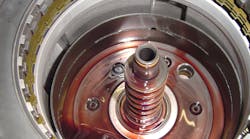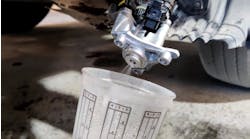Automatic transmission fluids (ATF) are some of the most complex fluids used in motor vehicles. They perform many functions in an engine including lubrication, heat dissipation, wear protection, shift quality and more, and are optimized for the special requirements of a transmission, such as valve operation, brake band friction and the torque converter, as well as gear lubrication. ATFs are even used as a hydraulic fluid in some power-assisted steering systems, as a lubricant in some 4WD transfer cases, and even in some modern manual transmissions.
"ATF's lubricate the most complex and sensitive major component of today's vehicles," says Steve Rober, National Sales Manager, Schaeffer Specialized Lubricants, a manufacturer of specialized motor oils, fuel additives, synthetic engine oils, industrial lubricants. www.schaefferoil.com. "Fluid design can play a major role in superior long-term function. Complex components, such as automatic transmissions, must have lubrication that cools, lubricates, resists oxidation from the high temperatures and allows clutch plates to smoothly engage and disengage thousands of times.
"As we look forward, we can only see more complicated multi-speed and electronically-controlled units requiring better fluids."
"Transmission fluids need to have excellent thermal stability to stand up to both high and low temperature extremes," says Ed Newman, Advertising Manager, AMSOIL, a manufacturer of synthetic lubricants and filters. www.amsoil.com. "In high temperatures, transmission fluid can't get too thin or it won't protect the vital gears and components of the transmission. The fluid also needs to prevent varnish and sludge deposits that can clog narrow oil passages.
"Transmission fluid has to be able to flow in extremely cold conditions to prevent slow shifting, which leads to a loss of fuel economy, and needs to provide excellent wear protection and frictional durability," Newman continues. "In the coming years, even smaller transmissions will be responsible for handling as much as, if not even more torque, so fluids will have even more pressure put on them."
Numerous varieties
The varieties and types of ATFs are substantial. Differences in viscosity, frictional properties and other factors create the necessity for more ATF selections. Many manufacturers have changed the formulation of their ATFs, sometimes within a year or two of the ATFs' introduction. These changes are becoming much more common and manufacturers' recommendations should be taken seriously.
"ATFs can first be generally classified into high and low viscosity oils," AMSOIL's Newman says. "For example, Dexron III was a standard General Motors transmission fluid for many years until it was replaced by the lower viscosity Dexron VI product. The major reason for lowering the viscosity is to improve fuel economy. Many OEMs now offer or require lower viscosity transmission fluids for their vehicles.
"The best description of fluid types is to describe them as conventional or mineral oil-based lubricants, synthetics processed from conventional base oils and synthesized hydrocarbon synthetic type fluids," says Mark Betner, Mystik Product Manager, CITGO, a refiner, transporter and marketer of transportation fuels, lubricants, petrochemicals and other industrial products. www.citgo.com. "Other lubricant descriptions and types may be rated using a manufacturers' performance rating or the American Petroleum Institute (API) standard, such as GL 1 through GL 5."
"Another distinct difference between ATF's is their frictional properties," says Newman. "Each transmission design may use different friction materials and the fluid has to be designed to work with these materials to avoid excessive slipping and/or chatter."
Newman adds that automatic transmissions have become increasingly complex, and that the need for specific ATF types for specific manufacturers' transmissions should continue in the future.
"Vehicle manufacturers are working harder than ever to increase efficiency while continuing to meet consumer demands," he says. "In the coming years, ATFs will have even more demand put on them with new fuel-efficiency CAFE (Corporate Average Fuel Economy) requirements coming into law. Systems will need to be even more efficient to meet these stringent new fuel mileage requirements."
Correct type
It might be laborious to search through the various varieties of ATFs, but it is essential to always use the correct type for the correct motor. Many manufacturers have their own specifications for the transmissions in their vehicles. Using an ATF not specified by the manufacturer can cause problems like wear in the transmission and erratic shifting, as well as have a negative impact on fuel efficiency if the viscosity of the oil is not correct.
"The viscosity alone can be an issue by itself," Rober of Schaeffer Specialized Lubricants says. "Mix in the chemistry and the wrong fluid, or a fluid that is not specified as a replacement, can cause complete failure."
"The type of transmission fluid can impact both the life and performance level of the transmission," Betner adds.
"The best thing vehicle owners can do is make sure the transmission fluid they are using meets the specification required by the OEM," AMSOIL's Newman says. "The specification can usually be found in the vehicle owner's manual.
"These specifications are created using the tolerances and designs of their transmissions in order to make sure that a transmission fluid can properly protect them. Since fluids are designed to work with specific transmissions, the owner risks problems by using a fluid that doesn't meet the specification they need. "
"Each manufacturer seems to think they know best the type of fluid that will do the job, and, therefore we are seeing an even more diverse branding and chemical makeup of these fluids," says Rober. "The trend is toward lighter fluids, mainly for better flow and fuel economy."
Service intervals
Not only is it vital to use the ATF recommended by the manufacturer, it is also important to have a proper maintenance schedule and follow each vehicle's specified intervals for lubricant servicing. Changing the fluid at the correct intervals can significantly increase the lifespan of the transmission.
"Drain intervals are important for several reasons," Newman of AMSOIL says. "First of all, the OEM's recommended intervals are based on the designs of their transmissions. New fluid will help replenish the additive package, increasing transmission life. Old dirty fluid can lead to lack of protection, increased wear, and transmission failures."
"The stress placed by newer, more complex transmissions stress the fluids more than ever, and they should be changed or sampled to assure maximum performance and life for modern transmissions," says Schaeffer's Rober.
"The manufacturer knows the specifications and lubrication requirements of the transmission," says Betner of CITGO. "These facts are matched with operating conditions, transmissions and general lubricant specs. In some cases, higher performance lubricants, such as synthetics, can extend the service life while optimizing transmission life."



